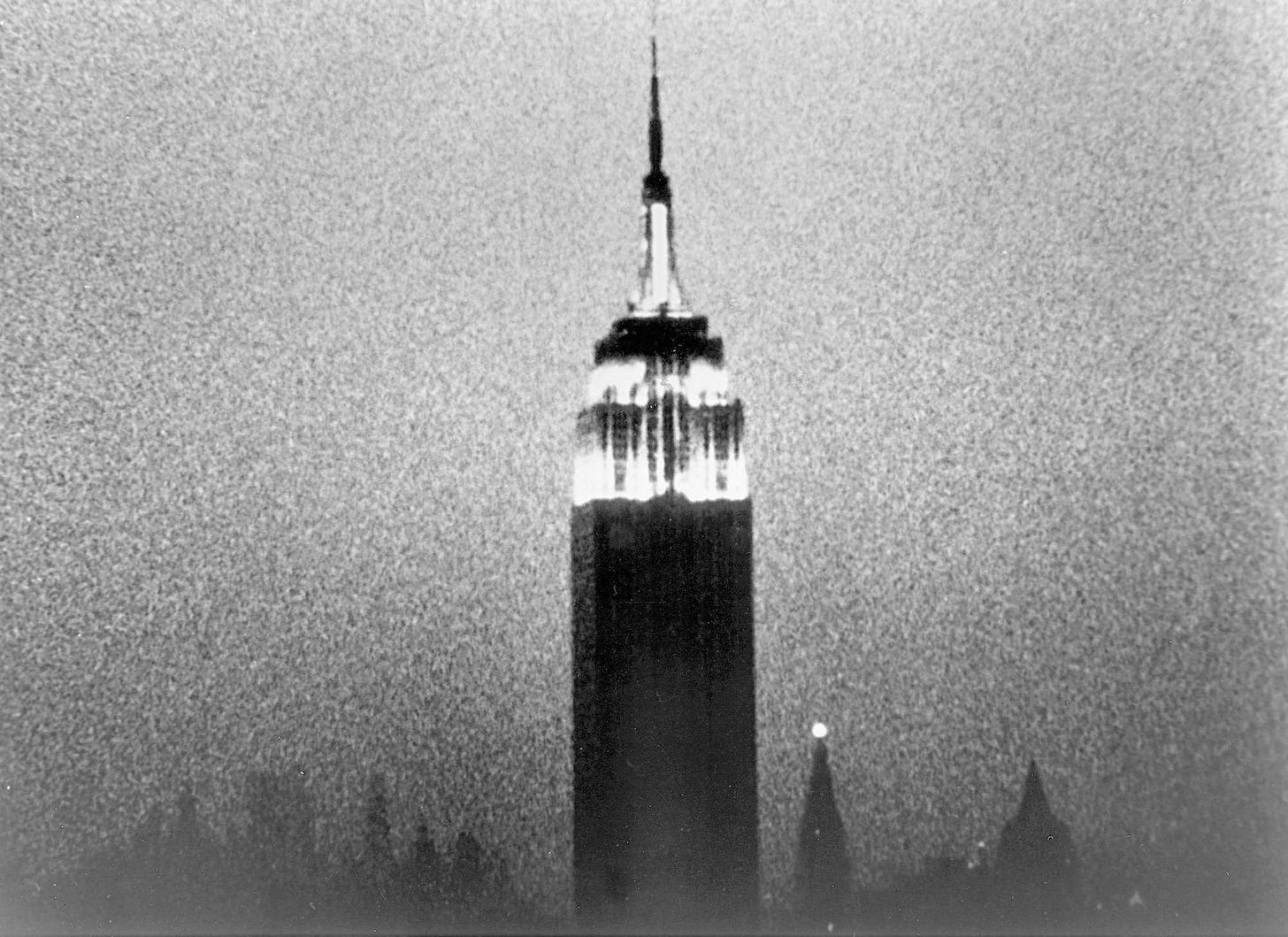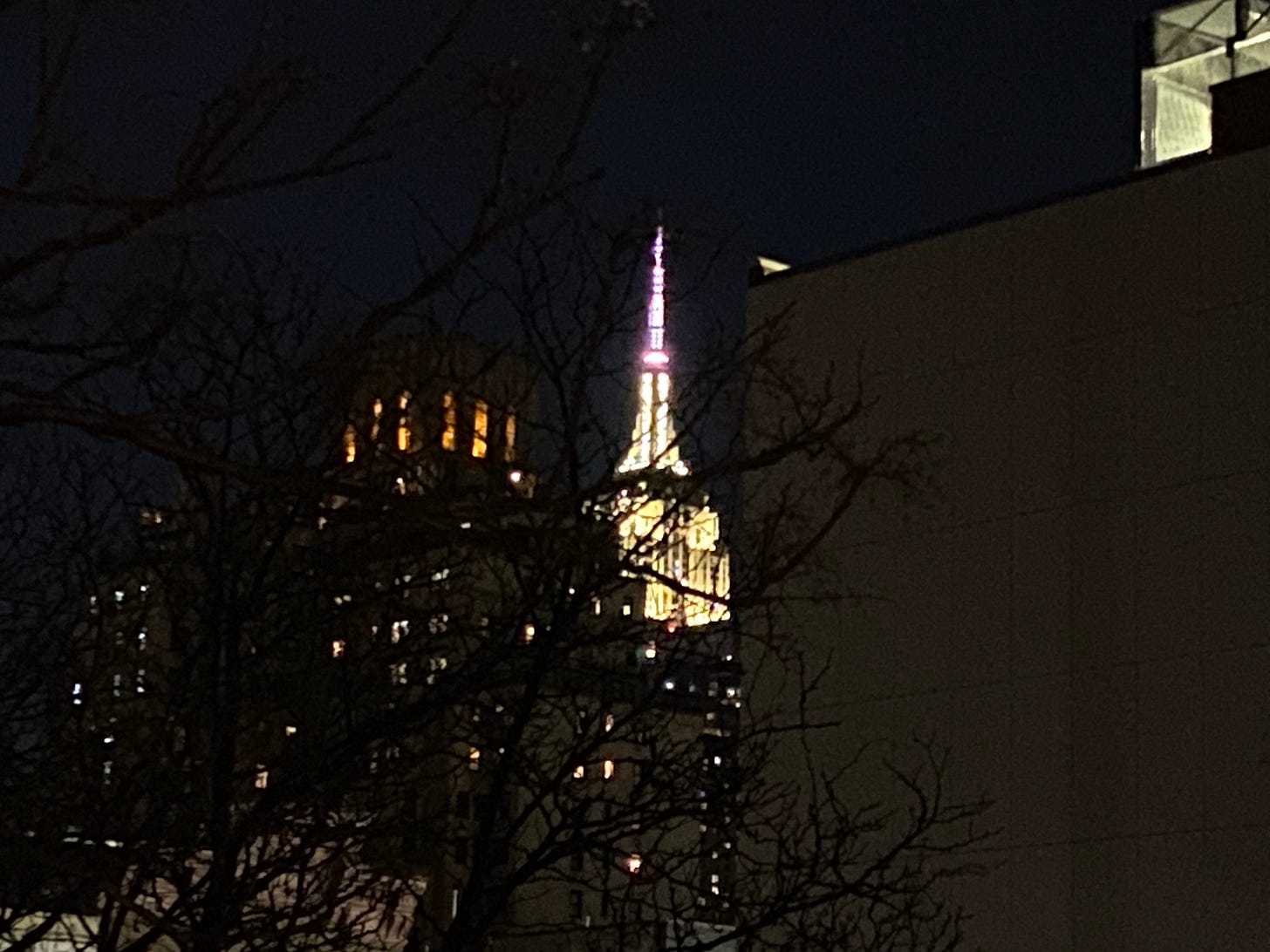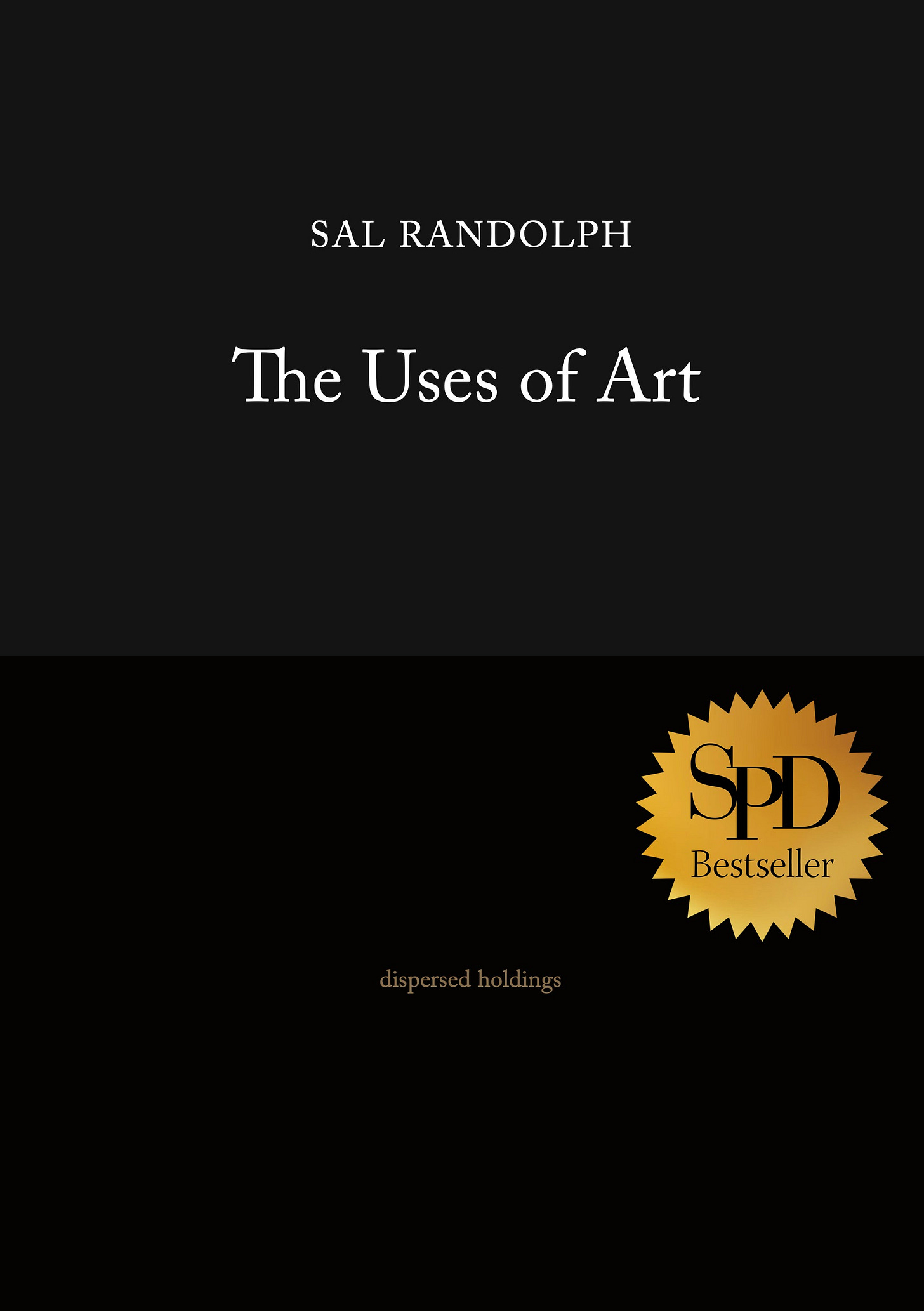The Wrong Empires of Andy Warhol & Eric Doeringer
Considering the Empires of Andy Warhol and Eric Doeringer.
Dear Friends,
A few weeks ago they finally removed the scaffolding from the school next door to me, restoring the Empire State Building as a character in my daily life. I can see it from my couch, or by standing and looking out the window, as it rises up in a crack of view between the school and the neighborhood buildings and trees. Sometimes it seems to dominate what I can see, other times it shrinks and recedes.
This week I consider what it means to look slowly at something, to extend your gaze past pleasure into the edges of boredom, to see what might be discovered there. What happens when the building outside my window is the star of a movie? What kind of attention does it ask for or deserve?
— Sal
Empire
Some months ago I sat in a darkened Zoom with thirty or forty other people, making our way through Andy Warhol’s Empire, or so we thought.
Together we all considered the creation of the film, the story that Andy and Jonas Mekas rented a room on the 41st floor of the Time-Life Building with a clear shot view of the Empire State Building. We learned about the rolls of film they used, and that Andy slowed down the six hours they shot so that the whole thing lasted eight. The shooting began at 8:06 pm. Evening came, and then darkness, lit by the building’s floodlights, and then deeper darkness as the floodlights finally turned off.
Empire is famous for its single subject, its still camera, and its relentless acceptance of whatever that camera recorded over the hours. It has frequently been declared unwatchable, though there are those who love it. Personally, I love Empire on principle. I am dedicated to slow forms of art, and have not yet met something so slow it outstretched my aesthetic longing. I even love Empire’s kitschy dependents: go to YouTube and search Slow TV, a genre inaugurated by a real-time train trip between Bergen and Oslo made for Norwegian television.
In truth, as a group, we were speeding our way through Empire, which seems funny now. We were talking about boredom and repetition, and their various uses. At a certain point we just stopped talking and watched.
Later I went back to see more of it, to feel more of its real time, and noticed that what I was seeing on the screen wasn’t actually anything like stills of Empire. This Empire was not that Empire. Our Empire had visible clouds and helicopters; the film stills were a gorgeous fog of film-grain. It seems Empire we had been streaming was a bootleg, a copy, even a copy of a copy.
After a little investigation, the video was revealed to be the work of Eric Doeringer, who had painstakingly made his own version Empire as part of a long running series of art recreations.
Eric Doeringer is a New York artist well known for his bootlegs of hot art-world commodities. He used to set up displays on the sidewalks of Chelsea, selling his small-scale knock-offs of paintings by Basquiat, John Currin, On Kawara, Damian Hirst, Elizabeth Peyton, Christopher Wool, and more—including, of course, Andy Warhol. I often saw him out there, and admired his anti-commodification re-commodification game. I own a few of his bootleg artist books.
Talking about Empire he says:
On the night of July 25/26, 1964, Andy Warhol shot his film Empire from the 41st floor of the Time Life Building in New York City. The film, with a running time of eight hours, is a static shot of the Empire State Building. The film opens at dusk. As night falls, the building's lights turn on. Shortly before the film ends, the lights are switched off. Otherwise, not much happens.
My film was shot on the night of July 25/26, 2012. The shooting began at approximately the same time as Warhol's film, so a similar slice of the evening was captured. As the original view no longer exists (due to numerous tall buildings being erected in midtown Manhattan over the intervening decades) my film was shot from a rooftop in Brooklyn.
Doeringer had uploaded his film onto YouTube in twelve segments. An enterprising YouTuber, @dradny, had later stitched these sections together and uploaded the whole seven hours, fifty-nine minutes, and forty-four seconds under the title Andy Warhol's ‘Empire.’ If you google around for Warhol’s Empire, that’s what you find, complete with the film’s description from Wikipedia. Such is our internet.
At first I was miffed. I hunted for any kind of streaming version of the real Warhol Empire, and found nothing. It doesn’t stream. The last time it was shown in its entirety was a 2014 screening at James Fuentes Gallery (described in detail by Blake Gopnik), though it was on also view as a kind of installation in MoMA’s collection galleries from fall 2020 through fall 2021. I’m not going to get to see it any time soon. But then I cheered up. Somehow it seems completely fitting that my Empire is the wrong Empire, that all of the experience I’ve had with it is with a cheap knock-off. Everyone has gotten very precious about Andy, and Andy was certainly a custodian of his own ego, but Andy’s work was also a deliberate puncturing of the art world’s self-seriousness.
Whether or not your Empire is the right one, it offers a temporal expanse for dreaming and contemplation. As in meditation, the stillness of the subject offers the possibility of watching your own mind move.
Wrong Empire
It’s fine to have nothing, to be empty of words, to let the clouds float very slowly in their changing configurations. No matter how slowly I write or think, I move faster than those clouds. I seem to move faster, but within the clouds there is constant motion. Within the building there is constant motion. Someone shuffling papers at a desk. A toilet flushing. An elevator going down. A daydream. A restlessness. A longing for someone not present. A bouncing knee. A fleeting desire. The keys of a typewriter banging down, the fingers that fly across those keys. It’s not the restlessness of the imaginary office worker, it’s my restlessness. A janitor rolling their cart, emptying trash cans as they go. It’s hard to imagine the inside life of the building—its inner life—as joyful. There is more boredom inside the building than out. Better to watch the silhouette against the sky, the stately, almost unmoving clouds. Watching the sky, watching the clouds, you can feel anything, be anywhere. Do we feel tenderness towards the building? Towards the spire, the aspiration, the city of dreams? The gaze returns to the core, to the dark obelisk. Planes and helicopters catch me as they fly by. What if one wrote continuously for all eight hours of the film? Would you go crazy in the dreaming and wandering? Would you get high? Would a narrative begin to emerge out of the nothing. To keep writing in the face of stillness. To keep going, really as we just do, whether we think of it or not. We keep going until death, breathing, digesting, our cells busy at their chemical festivals. We work, we eat, we sleep, we play. No surprise, really, that Andy filmed John Giorno sleeping. The long gaze as the gaze of love. Ardor or enmity. The photons pouring out of the sun to illuminate the clouds. Photons pouring upward from the floodlights, reaching for the sky. Photons meeting photons. The stillness of the film illuminates the dust and dirt on my screen. Vertical of the building, horizontals of the clouds, of the tiny planes crossing. Writing as going-on-being, as something much like the film, or like breathing. Stillness invites longing, it invites awareness of inner movement. I look at the building itself and come back to a sense of its dark presence. It’s all right that this doesn’t go anywhere, doesn’t become anything, doesn’t become useful or productive. Soon I will get up and walk my dog, soon I will take my laundry to the laundromat. A wobble and shimmy as the roll of film changes. It’s as if it never happened, as if I imagined the glitch. I wander away, restless, I open another page, I close the page, I come back. I notice a pain in my side, a complaining muscle. Another plane crosses, or is it a helicopter? The parakeet is singing. I have to pee. I’m going to get up and pee. I unfold my legs. I come back. The dog is watching me, wanting her walk (deserving her walk). Is there something that can happen if I keep going, if I push on into the restlessness, the, yes, boredom, but it’s not the film that’s boring. It’s only that I’m held here. It’s the holding the self in place that is the boredom. What would it mean to just go on? How long could I go on? Could I keep finding myself in the building? In the clouds? To be there for the end, for the punctuation, for something that might happen, for the plot point. Considering works in which the only plot points are birth and death, the beginning of the work and the end of the work. Continuous spaces, atmospheres, ambiences, help you taste endlessness and continuity, but in truth we know they will end, or we will end them, get up and walk away, go on to the next task, the next appointment. It’s all nextness. But do we also hark back to the beginning, the birth, the moment when we weren’t in this atmosphere, and then we were? A sharp, retroactive punctuation. And in that punctuation, a goodbye.
While you can’t stream Andy Warhol’s Empire (let me know if I’m wrong about this!) you can watch all five hours and twenty minutes of Sleep on the internet archive.
You can find Eric Doeringer’s remake of Empire here, and see YouTube user @dradny’s eight-hour version here. More about Eric Doeringer here, and here.
Further adventures and new ways of seeing can be found in my book, The Uses of Art.
Artist Sal Randolph’s THE USES OF ART is a memoir of transformative encounters with works of art, inviting readers into new methods of looking that are both liberating and emboldening.
Dazzlingly original, ferociously intelligent.
— Michael Cunningham
A joyful, dazzling treasure-box of a book.
— Bonnie Friedman
Here’s a guide, to waking up, over and over again.
— Roshi Pat Enkyo O’Hara









Just watched The Andy Warhol Diaries on Netflix, this was a delightful postscript.
While reading, I wanted to imagine that somebody in your zoom call had rented a room on the 41st floor of the Time-Life building and had just put their laptop in the window...